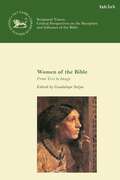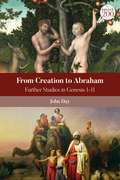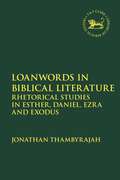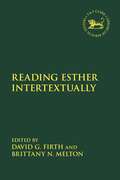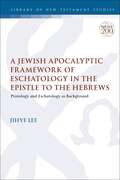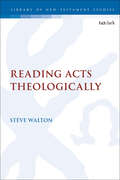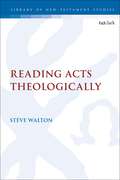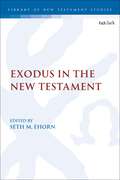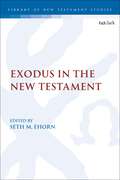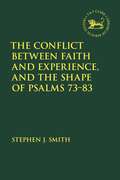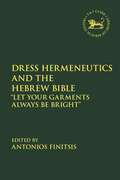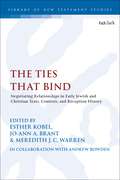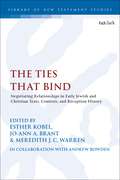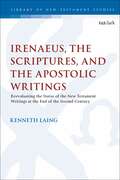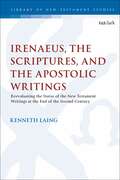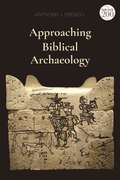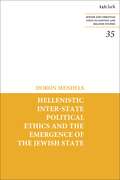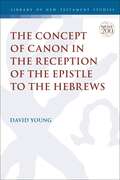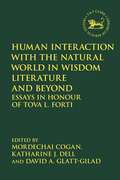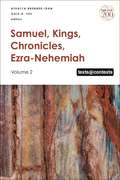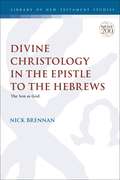- Table View
- List View
Women of the Bible: From Text to Image (The Library of Hebrew Bible/Old Testament Studies)
The Hebrew Bible and art reside at the core of this book, which analyzes the iconographic representation of several women of the Bible. The contributors consider the ways in which the biblical texts regarding these women had been read and understood throughout time and the means by which they were represented. Each study also explores the different values associated with these representations according to the problems, worries and concerns of each period. Drawing upon disciplines such as theology, philology or history of art, the essays within this volume provide a cross-sectional, plural and rich approach. In focusing upon iconographic representation, numerous visual cultures of the last millennium are explored, and special emphasis is placed upon several integral biblical women such as Bathsheba, Moses' mother, the Pharaoh's Daughter, Ruth, Naomi and Deborah, and their lasting influence upon Western art and culture. This book pursues an understanding of the history of the transmission and reception of the Bible in general, and of the women of the Old Testament in particular.
From Creation to Abraham: Further Studies in Genesis 1-11 (The Library of Hebrew Bible/Old Testament Studies)
by John DayJohn Day investigates disputed points of interpretation within Genesis 1-11, expanding on his earlier book From Creation to Babel with 11 stimulating essays. Day considers the texts within their Near Eastern contexts, and pays particular attention to the later history of interpretation and reception history.Topics covered include the meaning of the Bible's first verse and what immediately follows, as well as what it means that humanity is made in the image of God. Further chapters examine the Garden of Eden, the background and role of the serpent and the ambiguous role of Wisdom; the many problems of interpretation in the Cain and Abel story, as well as what gave rise to this story; how the Covenant with Noah and the Noachic commandments, though originally separate, became conflated in some later Jewish thought; and the location of 'Ur of the Chaldaeans', Abraham's alleged place of origin, and how this was later misinterpreted by Jewish, Christian and Islamic sources as referring to a 'fiery furnace of the Chaldaeans'. These chapters, which illuminate the meaning, background and subsequent interpretation of the Book of Genesis, pave the way for Day's forthcoming ICC commentary on Genesis 1-11.
Loanwords in Biblical Literature: Rhetorical Studies in Esther, Daniel, Ezra and Exodus (The Library of Hebrew Bible/Old Testament Studies)
by Jonathan ThambyrajahIn contrast to previous scholarship which has approached loanwords from etymological and lexicographic perspectives, Jonathan Thambyrajah considers them not only as data but as rhetorical elements of the literary texts of which they are a part. In the book, he explains why certain biblical texts strongly prefer to use loanwords whereas others have few. In order to explore this, he studies the loanwords of Esther, Daniel, Ezra and Exodus, considering their impact on audiences and readers. He also analyzes and evaluates the many proposed loan hypotheses in Biblical Hebrew and proposes further or different hypotheses.Loanwords have the potential to carry associations with its culture of origin, and as such are ideal rhetorical tools for shaping a text's audience's view of the nations around them and their own nation. Thambyrajah also focuses on this phenomenon, looking at the court tales in Esther and Daniel, the correspondence in the Hebrew and Aramaic sections of Ezra 1–7, and the accounts of building the tabernacle in Exodus, and paying close attention to how these texts present ethnicity.
Reading Esther Intertextually (The Library of Hebrew Bible/Old Testament Studies)
Looking at the Book of Esther through the lens of intertextuality, this collection considers its connections with each division of the Hebrew Bible, along with texts throughout history. Through its exploration, it provides and invites further study into the relationship between Esther and its intertexts, many which are under explored. Topics covered in the book include considerations of Esther alongside the Torah and the prophetic books, as well as in dialogue with the Qumran community.As an edited collection, the book draws together scholars with expertise in the wide variety of texts that are intertextually connected with Esther, offering the reader a more nuanced and informed discussion. By including some reflection on the nature of intertextuality as a 'method', it also enables the reader to appreciate the varying intertextual approaches currently employed in biblical studies. In applying these to a focused analysis of Esther, this collection will facilitate greater insight on both the book of Esther and current methodological research.
A Jewish Apocalyptic Framework of Eschatology in the Epistle to the Hebrews: Protology and Eschatology as Background (The Library of New Testament Studies)
by Jihye LeeIn contrast to scholarly belief that the author of the Epistle to the Hebrews envisions the transcendent, heavenly world as the eschatological inheritance of God's people, Jihye Lee argues that a version of an Urzeit-Endzeit eschatological framework - as observed in some Jewish apocalyptic texts - provides a plausible background against which the arguments of Hebrews are most comprehensively explained. Instead of transcendence to the heavenly world that will come after the destruction of the shakable creation, Lee suggests the possibility of a more dualistic new world.By first defining Urzeit-Endzeit eschatology, Lee is then able to explore its place in both pre and post 70 CE Second Temple Judaism. In examining Enoch, the Qumran Texts, Jubilees, the Liber Antiquitatum Biblicarum, 4 Ezra and 2 Baruch and finally the Book of Revelation, Lee compares a multitude of eschatological visions and the different depictions of the transformation of the world, judgement and the new world to come. Bringing these texts together to analyse the issue of God's Rest in Hebrews, and the nature of the Unshakable Kingdom, Lee concludes that Hebrews envisions the kingdom as consisting of both the revealed heavenly world and the renewed creation as the eschatological venue of God's dwelling place with his people.
A Jewish Apocalyptic Framework of Eschatology in the Epistle to the Hebrews: Protology and Eschatology as Background (PDF) (The Library of New Testament Studies)
by Jihye LeeIn contrast to scholarly belief that the author of the Epistle to the Hebrews envisions the transcendent, heavenly world as the eschatological inheritance of God's people, Jihye Lee argues that a version of an Urzeit-Endzeit eschatological framework - as observed in some Jewish apocalyptic texts - provides a plausible background against which the arguments of Hebrews are most comprehensively explained. Instead of transcendence to the heavenly world that will come after the destruction of the shakable creation, Lee suggests the possibility of a more dualistic new world.By first defining Urzeit-Endzeit eschatology, Lee is then able to explore its place in both pre and post 70 CE Second Temple Judaism. In examining Enoch, the Qumran Texts, Jubilees, the Liber Antiquitatum Biblicarum, 4 Ezra and 2 Baruch and finally the Book of Revelation, Lee compares a multitude of eschatological visions and the different depictions of the transformation of the world, judgement and the new world to come. Bringing these texts together to analyse the issue of God's Rest in Hebrews, and the nature of the Unshakable Kingdom, Lee concludes that Hebrews envisions the kingdom as consisting of both the revealed heavenly world and the renewed creation as the eschatological venue of God's dwelling place with his people.
Reading Acts Theologically (The Library of New Testament Studies)
by Steve WaltonSteve Walton has consistently focused his research and scholarship upon the theological perspective of Acts, while considering the book's nature and focus, its portrait of the early Christian communities and their mission in the culturally varied first-century world, and its major theological themes. Walton now collects several of his key essays into an expansive and coherent perspective, bringing together studies published over nearly two decades during his time of study and reflection in the process of writing the Word Biblical Commentary on Acts.The collection begins with an exploration of what 'reading Acts theologically' means, the divine perspective of Acts, and how Luke theologizes through narrative. Walton presents analyses covering the nature of the early Church and the main terms used by the communities; the believers' sharing of possessions; early Christian attitudes to the Jewish temple; decision-making among the earliest Christians; and the church's engagement with the Roman empire and its representatives. This volume studies theological themes in Acts such as Jesus' role as a character in the text while also located in heaven, and the cosmology and anthropology communicated by Acts, thus providing a new reflection on the early Christian understanding of God, Jesus and humanity.
Reading Acts Theologically (The Library of New Testament Studies)
by Steve WaltonSteve Walton has consistently focused his research and scholarship upon the theological perspective of Acts, while considering the book's nature and focus, its portrait of the early Christian communities and their mission in the culturally varied first-century world, and its major theological themes. Walton now collects several of his key essays into an expansive and coherent perspective, bringing together studies published over nearly two decades during his time of study and reflection in the process of writing the Word Biblical Commentary on Acts.The collection begins with an exploration of what 'reading Acts theologically' means, the divine perspective of Acts, and how Luke theologizes through narrative. Walton presents analyses covering the nature of the early Church and the main terms used by the communities; the believers' sharing of possessions; early Christian attitudes to the Jewish temple; decision-making among the earliest Christians; and the church's engagement with the Roman empire and its representatives. This volume studies theological themes in Acts such as Jesus' role as a character in the text while also located in heaven, and the cosmology and anthropology communicated by Acts, thus providing a new reflection on the early Christian understanding of God, Jesus and humanity.
Exodus in the New Testament (The Library of New Testament Studies)
by Seth M. Ehorn & contributorsIn focusing exclusively on the book of Exodus and its constant allusions in the New Testament, this new collection of studies seeks both to increase knowledge of the textual transmission of Exodus in the first century, and to encourage further methodological reflection on the use of Scripture vs. scriptural traditions as employed by ancient authors.First exploring the role of Exodus within Judaism in the Second Temple Period, the contributors then reflect upon the rhetorical impact of Exodus citations and allusions in the New Testament. By taking the reader from the Four Gospels through the Pauline and Disputed Letters and Hebrews, and all the way to Revelation itself, this volume demonstrates both the unity and the diversity of appeals to Exodus traditions in Jewish and Christian literature within the Second Temple Period.
Exodus in the New Testament (The Library of New Testament Studies)
In focusing exclusively on the book of Exodus and its constant allusions in the New Testament, this new collection of studies seeks both to increase knowledge of the textual transmission of Exodus in the first century, and to encourage further methodological reflection on the use of Scripture vs. scriptural traditions as employed by ancient authors.First exploring the role of Exodus within Judaism in the Second Temple Period, the contributors then reflect upon the rhetorical impact of Exodus citations and allusions in the New Testament. By taking the reader from the Four Gospels through the Pauline and Disputed Letters and Hebrews, and all the way to Revelation itself, this volume demonstrates both the unity and the diversity of appeals to Exodus traditions in Jewish and Christian literature within the Second Temple Period.
The Conflict Between Faith and Experience, and the Shape of Psalms 73–83 (The Library of Hebrew Bible/Old Testament Studies)
by Stephen J. SmithStephen J. Smith enters the lively field of editorial-criticism of the Hebrew Psalter or Psalterexegese with this detailed investigation into the final form of Psalms 73-83. In the book, he engages scholarly disagreements over this collection's structure, the degree and nature of its literary unity, and the primary theological message(s) it communicates. Smith argues that the sequence of Psalms 73–82 - and possibly 83 – has a deliberate design that reflects a sustained focus on addressing, and resolving, a multidimensional collision between “faith” (i.e., core Israelite beliefs about God) and “experience” (i.e., the individual/community's lived experience of God) that was precipitated by God's prolonged absence in the Temple's destruction (c. 586/587 BCE). Parting ways with previous scholarship, Smith contends that a recursive organizing principle rooted in biblical parallelism structures the collection. Over the book's nine chapters, he makes the case that the editor(s) grouped its psalms into two major blocks (74-78; 79-82) of two sub-groupings each (74-76, 77-78; 79/82, 80-81) in order to develop a single topic in multiple dimensions: the severe threat that God's prolonged absence in the temple's destruction posed to the ongoing viability of various core Israelite beliefs about God, most fundamentally God's goodness. Smith makes the case that the collection is shaped to resolve this crisis by bolstering the reader's confidence in, and commitment to, these beliefs in the face of their apparent failure.
Dress Hermeneutics and the Hebrew Bible: "Let Your Garments Always Be Bright" (The Library of Hebrew Bible/Old Testament Studies)
Antonios Finitsis and contributors continue their examination of dress and clothing in the Hebrew Bible in this collection of illuminating essays. Straddling the divide between the material and the ideological, this book lends shape and texture to topics including social standing, agency, and the motif of cloth and clothing in Esther. Essays also explore the function of dress metaphors in imprecatory Psalms, the symbolic function of headdresses, and the divine clothing of Adam and Eve and the hermeneutics of trauma recovery. Together, the contributors continue to shape scholarly discourse on a growing body of scholarship on dress in the Bible.By turning their analytical gaze to this primary evidence, the contributors are able to reveal the social, psychological, aesthetic, ideological and symbolic meanings of dress in the Hebrew Bible, thereby producing insights into the literature and cultural world of the ancient Near East.
The Ties that Bind: Negotiating Relationships in Early Jewish and Christian Texts, Contexts, and Reception History (The Library of New Testament Studies)
by Esther KobelFriendship and other intimate (but not always amicable) relationships have received some attention in the greater field of research on early Judaism and Christianity, though not as much as deserved. This volume celebrates and builds upon the life-long work of Adele Reinhartz, covering the various permutations of relationships that can be found in the Gospel of John, the wider corpus of early Jewish and Christian literature, and cinematic re-imaginings thereof.While the issue of whether one can 'befriend' the Fourth Gospel in light of the book's legacy of antisemitism is central to many of the essays in this volume, others address other more or less likely friendships: Pilate, Paul, Lazarus, Judas, or Mary Magdalene. Likewise, the bonds between ancient texts and contemporary retellings of their stories feature prominently, with contributors asking what kinds of relationships filmmakers encourage their audiences to have with their subjects. This volume explores some of the rich variety of relationships in the ancient world, and unpacks the intricate and dynamic processes and interactions by which human relationships and societies are generated, maintained, and dissolved.
The Ties that Bind: Negotiating Relationships in Early Jewish and Christian Texts, Contexts, and Reception History (The Library of New Testament Studies)
Friendship and other intimate (but not always amicable) relationships have received some attention in the greater field of research on early Judaism and Christianity, though not as much as deserved. This volume celebrates and builds upon the life-long work of Adele Reinhartz, covering the various permutations of relationships that can be found in the Gospel of John, the wider corpus of early Jewish and Christian literature, and cinematic re-imaginings thereof.While the issue of whether one can 'befriend' the Fourth Gospel in light of the book's legacy of antisemitism is central to many of the essays in this volume, others address other more or less likely friendships: Pilate, Paul, Lazarus, Judas, or Mary Magdalene. Likewise, the bonds between ancient texts and contemporary retellings of their stories feature prominently, with contributors asking what kinds of relationships filmmakers encourage their audiences to have with their subjects. This volume explores some of the rich variety of relationships in the ancient world, and unpacks the intricate and dynamic processes and interactions by which human relationships and societies are generated, maintained, and dissolved.
Irenaeus, the Scriptures, and the Apostolic Writings: Reevaluating the Status of the New Testament Writings at the End of the Second Century (The Library of New Testament Studies)
by Kenneth LaingKenneth Laing challenges the concept of Irenaeus as the primary witness to the point at which the New Testament achieved scriptural status, and calls into question some of the most basic conclusions and assumptions of New Testament canon formation scholarship. Laing proposes a new interpretation of Irenaeus' understanding of the nature and basis of authority of the New Testament writings, based on his christocentric theology of revelation. By exploring the texts themselves, the concept of authority, scriptural tradition and the question of inspiration, Laing argues that while the writings possess authority equal to the Jewish scriptures, it is their apostolic origin and the apostles' relationship to Christ – not inspiration – which forms the basis of the unique revelatory authority of the New Testament writings. Laing thus stresses that Irenaeus regards the New Testament writings as a written record of the apostolic tradition and the primary means of accessing its content, rather than as a purely scriptural text.
Irenaeus, the Scriptures, and the Apostolic Writings: Reevaluating the Status of the New Testament Writings at the End of the Second Century (The Library of New Testament Studies)
by Kenneth LaingKenneth Laing challenges the concept of Irenaeus as the primary witness to the point at which the New Testament achieved scriptural status, and calls into question some of the most basic conclusions and assumptions of New Testament canon formation scholarship. Laing proposes a new interpretation of Irenaeus' understanding of the nature and basis of authority of the New Testament writings, based on his christocentric theology of revelation. By exploring the texts themselves, the concept of authority, scriptural tradition and the question of inspiration, Laing argues that while the writings possess authority equal to the Jewish scriptures, it is their apostolic origin and the apostles' relationship to Christ – not inspiration – which forms the basis of the unique revelatory authority of the New Testament writings. Laing thus stresses that Irenaeus regards the New Testament writings as a written record of the apostolic tradition and the primary means of accessing its content, rather than as a purely scriptural text.
Approaching Biblical Archaeology
by Anthony J. FrendoAnthony J. Frendo introduces biblical students and scholars alike to the discipline of archaeology by explaining how the minds of professional archaeologists work, explaining what archaeologists seek, how they go about doing so, and how they interpret their data. Frendo shows those engaged in biblical scholarship how they can properly integrate biblical research with archaeological discoveries in a way that allows the bible and archaeology to be viewed and kept as distinct disciplines, the respective results of which, where relevant, may be integrated in productive discussion. Frendo also examines how the archaeology of the ancient Near East (particularly that of the southern Levant) has an essential bearing on how scholars can better appreciate the text of the bible, including its religious message. Frendo examines such matters as artefacts, stratigraphy and chronology, and archaeological reasoning. He also demonstrates that, whilst generally it is archaeology that casts light on the biblical text, at points biblical interpretation can help archaeologists to understand certain data.
Hellenistic Inter-state Political Ethics and the Emergence of the Jewish State (Jewish and Christian Texts)
by Doron MendelsAgainst the background of a reconstructed inter-state ethical code, the rise of the Hasmoneans,Judea's ruling dynasty, is given a new perspective. Doron Mendels explores how concepts such as liberty, justice, fairness, loyalty, reciprocity, adherence to ancestral laws, compassion, accountability and love of fatherland became meaningful in the relations between nations in the Hellenistic Mediterranean sphere, as well as between ruling empires and their subject states. The emerging Jewish state echoed this ethical system.
Hellenistic Inter-state Political Ethics and the Emergence of the Jewish State (Jewish and Christian Texts)
by Doron MendelsAgainst the background of a reconstructed inter-state ethical code, the rise of the Hasmoneans,Judea's ruling dynasty, is given a new perspective. Doron Mendels explores how concepts such as liberty, justice, fairness, loyalty, reciprocity, adherence to ancestral laws, compassion, accountability and love of fatherland became meaningful in the relations between nations in the Hellenistic Mediterranean sphere, as well as between ruling empires and their subject states. The emerging Jewish state echoed this ethical system.
The Concept of Canon in the Reception of the Epistle to the Hebrews (The Library of New Testament Studies)
by David YoungDavid Young argues that the reception of the Epistle to the Hebrews in early Christianity was influenced by a number of factors which had little to do with debates about an authoritative canon of Christian writings, and which were primarily the concern of a relatively small group of highly educated scholars. Through careful study of the quotations and reproductions of Hebrews in their own rhetorical and material context, Young stresses that the concept of canon had little bearing on its early reception. By exploring the transformation of authorship into authority, the patristic citations of Hebrews, the Epistle's position in edited collections of the Pauline corpus and the consequences of translation, this complex reception history illustrates the myriad ways in which early Christians thought of and interacted with their scriptures.
The Concept of Canon in the Reception of the Epistle to the Hebrews (The Library of New Testament Studies)
by David YoungDavid Young argues that the reception of the Epistle to the Hebrews in early Christianity was influenced by a number of factors which had little to do with debates about an authoritative canon of Christian writings, and which were primarily the concern of a relatively small group of highly educated scholars. Through careful study of the quotations and reproductions of Hebrews in their own rhetorical and material context, Young stresses that the concept of canon had little bearing on its early reception. By exploring the transformation of authorship into authority, the patristic citations of Hebrews, the Epistle's position in edited collections of the Pauline corpus and the consequences of translation, this complex reception history illustrates the myriad ways in which early Christians thought of and interacted with their scriptures.
Human Interaction with the Natural World in Wisdom Literature and Beyond: Essays in Honour of Tova L. Forti (The Library of Hebrew Bible/Old Testament Studies)
Created in honor of the work of Professor Tova Forti, this collection considers the natural world in key wisdom books - Proverbs, Job and Qoheleth/Ecclesiastes, Ben Sira and Song of Songs/Solomon - and also examines particular animal and plant imagery in other texts in the Hebrew Bible. It crucially involves ancient Near Eastern parallels and like texts from the classical world, but also draws on rabbinic tradition and broader interpretative works, as well as different textual traditions such as the LXX and Qumran scrolls.Whilst the natural world, notably plants and animals, is a key uniting element, the human aspect is also crucial. To explore this, contributors also treat the wider concerns within wisdom literature on human beings in relation to their social context, and in comparison with neighbouring nations. They emphasize that the human, animal and plant worlds act together in synthesis, all enhanced and imbued by the world-view of wisdom literature.
Samuel, Kings, Chronicles, Ezra-Nehemiah: Volume 2 (Texts @ Contexts)
by Athalya Brenner-Idan and Gale A. YeeThis volume brings together disparate views about biblical texts in the books of Samuel, Chronicles and Ezra-Nehemiah and examines their influence in the life of contemporary communities, demonstrating how today's environments and disorders help readers to acquire new insights into such texts.The contributing scholars hail from different continents - from East Asia to the United States to Europe to South Africa and Israel - and count themselves as members of various Jewish and Christian traditions or secularist ways of life. But, in spite of their differences in location and community membership, and perhaps in the spirit of the times (2020 and its global discontents), they share preoccupations with questions of ethics in politics and life, 'proper' death, violence and social exclusion or inclusion. This volume offers readers a better understanding of how politics and faith can be melded, both in ancient and contemporary contexts, to serve the interests of certain classes and societies, often at the expense of others.
Samuel, Kings, Chronicles, Ezra-Nehemiah: Volume 2 (Texts @ Contexts)
This volume brings together disparate views about biblical texts in the books of Samuel, Chronicles and Ezra-Nehemiah and examines their influence in the life of contemporary communities, demonstrating how today's environments and disorders help readers to acquire new insights into such texts.The contributing scholars hail from different continents - from East Asia to the United States to Europe to South Africa and Israel - and count themselves as members of various Jewish and Christian traditions or secularist ways of life. But, in spite of their differences in location and community membership, and perhaps in the spirit of the times (2020 and its global discontents), they share preoccupations with questions of ethics in politics and life, 'proper' death, violence and social exclusion or inclusion. This volume offers readers a better understanding of how politics and faith can be melded, both in ancient and contemporary contexts, to serve the interests of certain classes and societies, often at the expense of others.
Divine Christology in the Epistle to the Hebrews: The Son as God (The Library of New Testament Studies)
by Nick BrennanNick Brennan investigates the depiction of the Son's divine nature in the Epistle to the Hebrews; despite little attention being directly given to the Son's divinity in recent study of Hebrews, Brennan argues that not only is the Son depicted as divine in the Epistle, but that this depiction ranges outside the early chapters in which it is most often noted, and is theologically relevant to the pattern of the Author's argument.Beginning with a survey of the state of contemporary scholarship on the Son's divinity in Hebrews, and a discussion of the issues connected to predicating divinity of the Son in the Epistle, Brennan analyses the application of Old Testament texts to the Son which, in their original context, refer to God (1:6; 10–12), and demonstrates how the Pastor not only affirms the Son's divinity but also the significance of his exaltation as God. He then discusses how Heb 3:3, 4 witnesses to the divinity of the Son in Hebrews, explores debates on the relation of the Son's “indestructible life” (Heb 7:16) to his divinity, and demonstrates how two key concepts in Hebrews (covenant and sonship) reinforce the Son's divinity. Brennan thus concludes that the Epistle not only portrays the Son as God, but does so in a manner which is a pervasive aspect of its thought, and is theologically salient to many features of the Epistle's argument.
